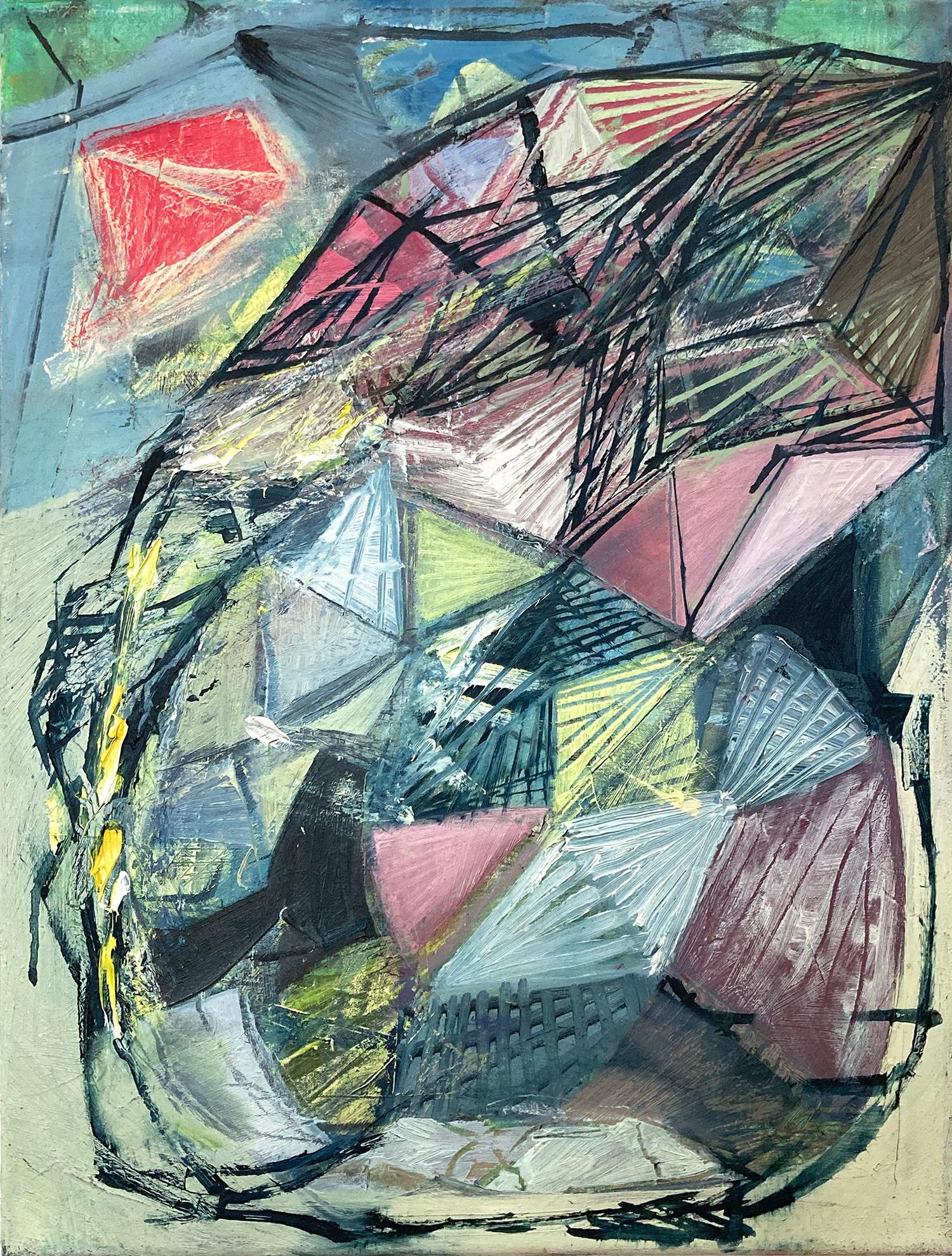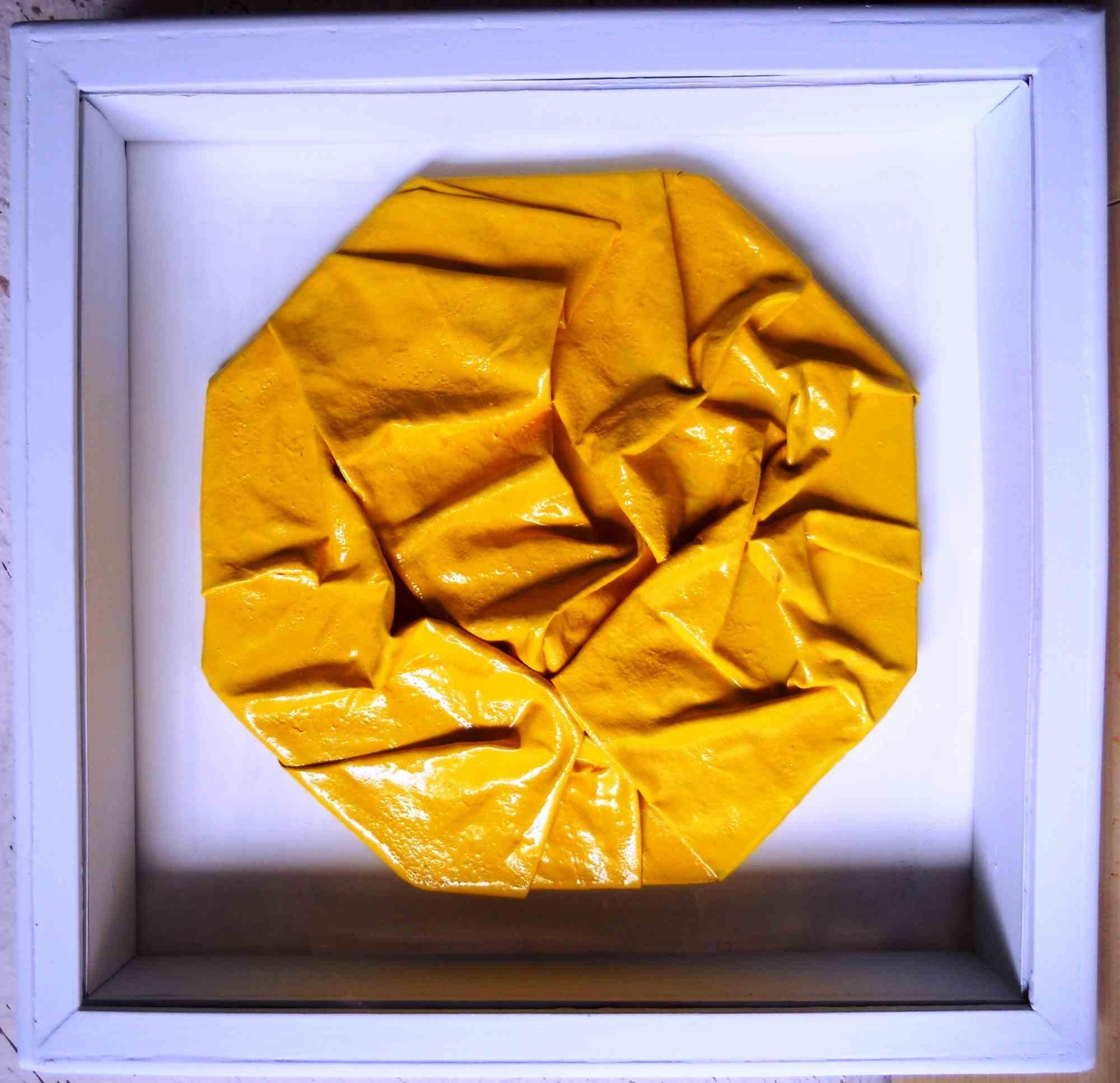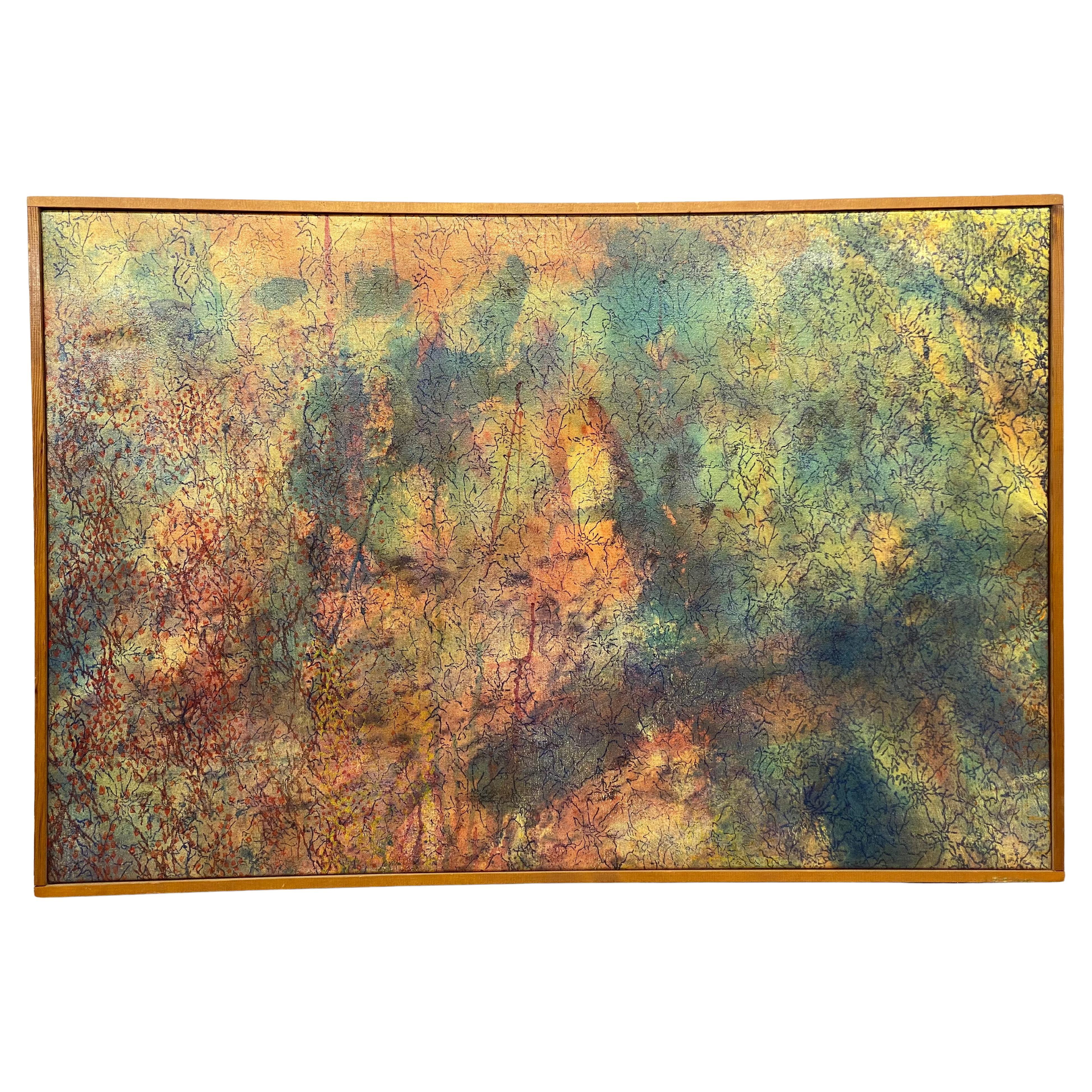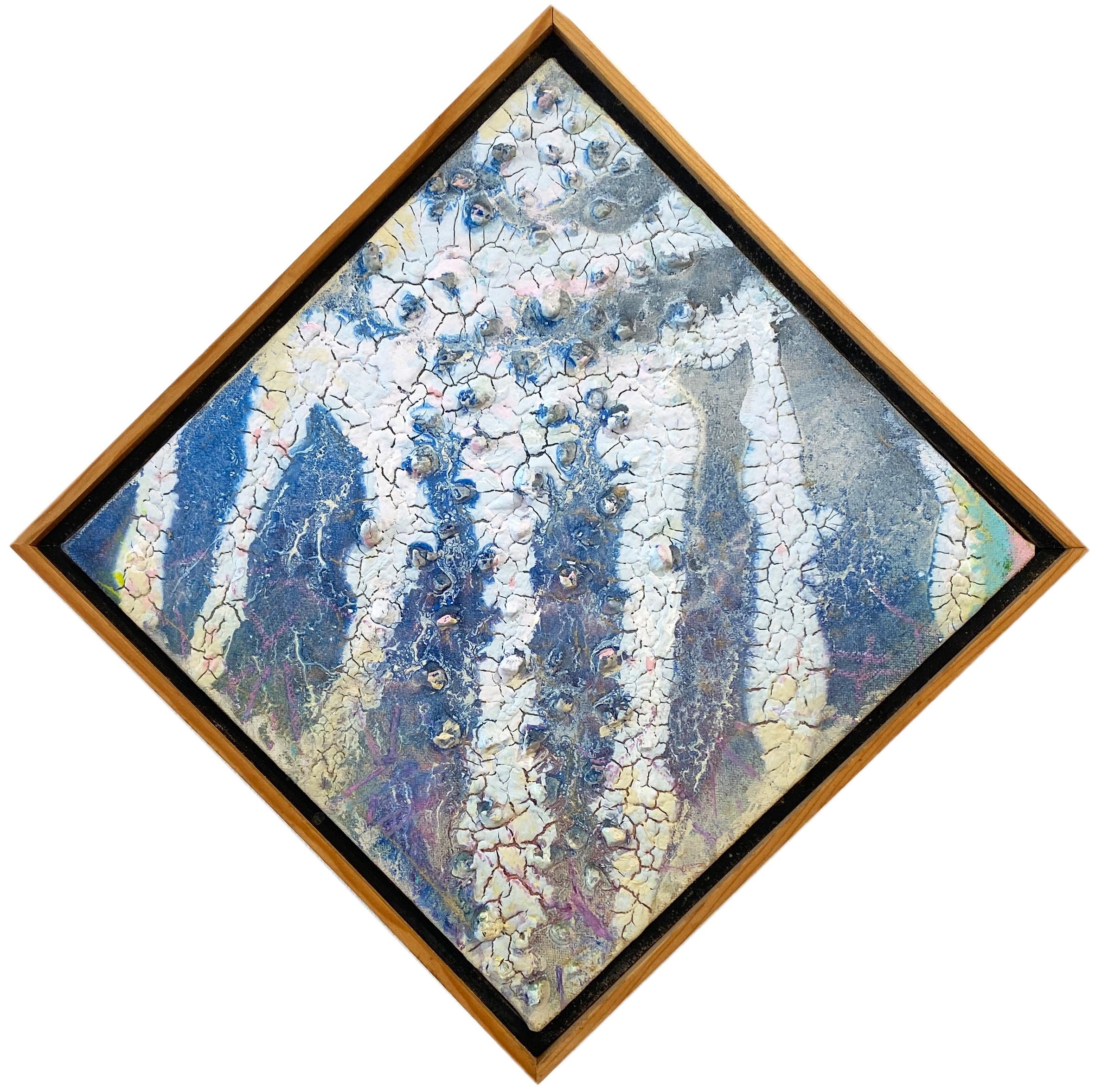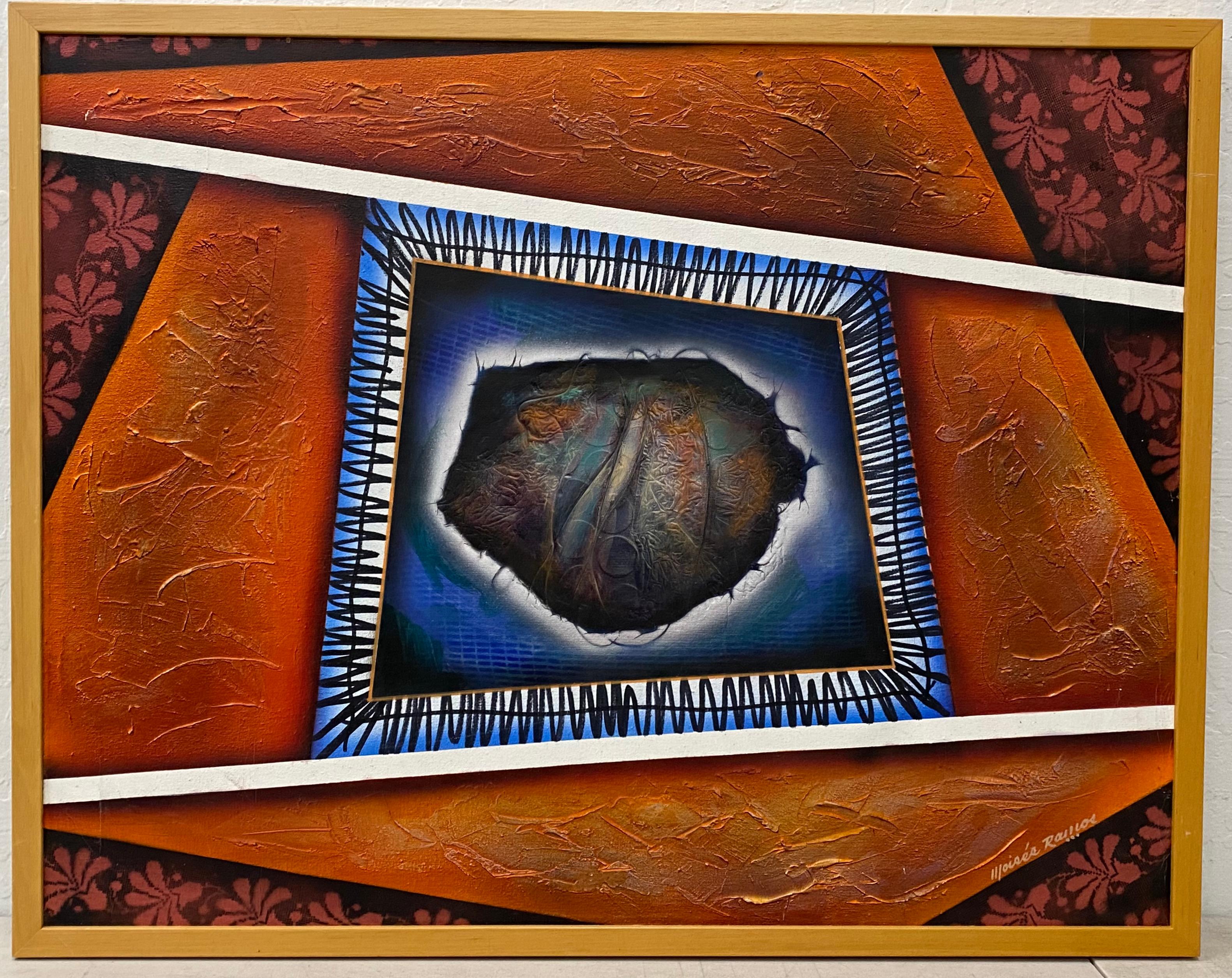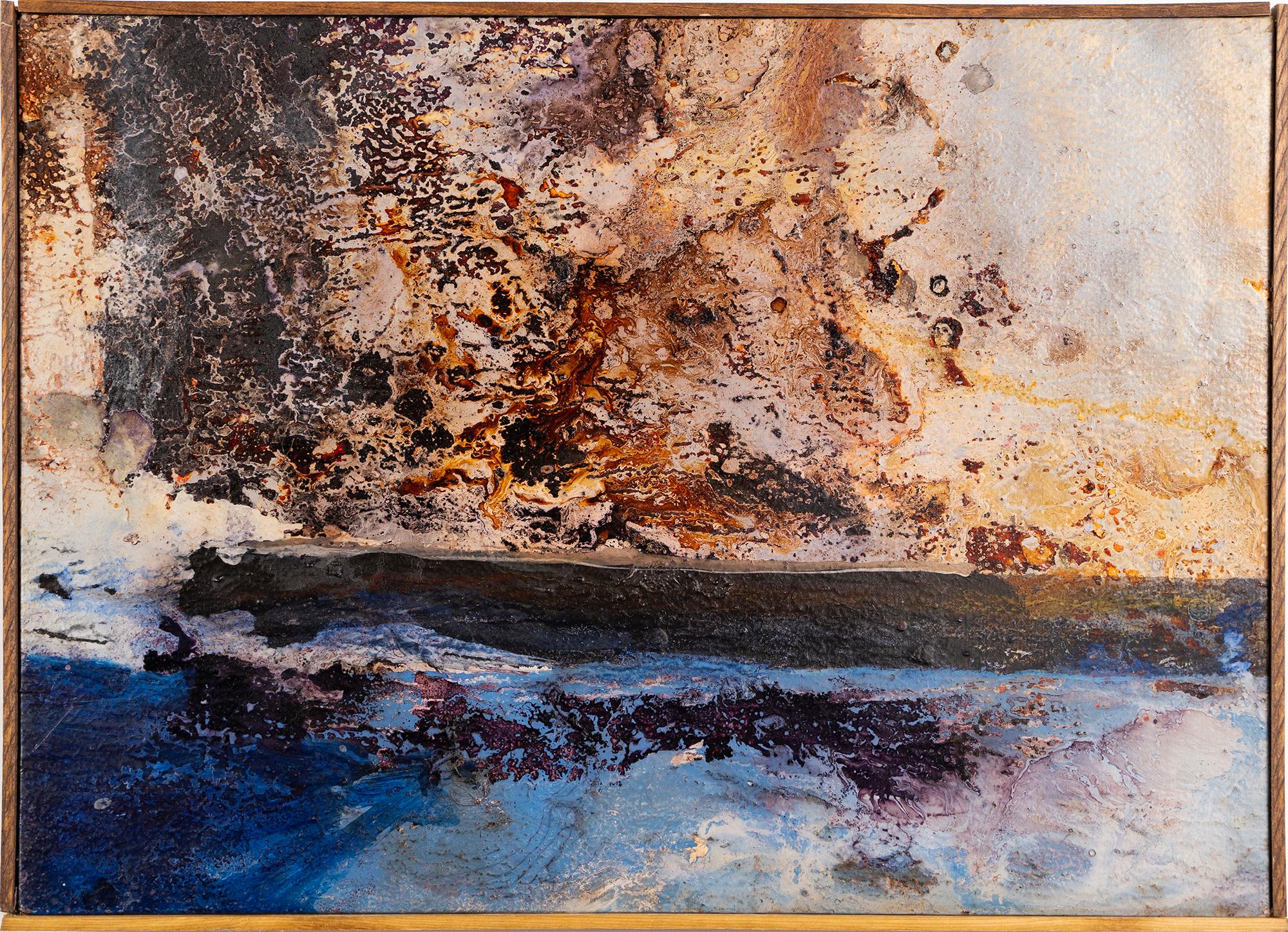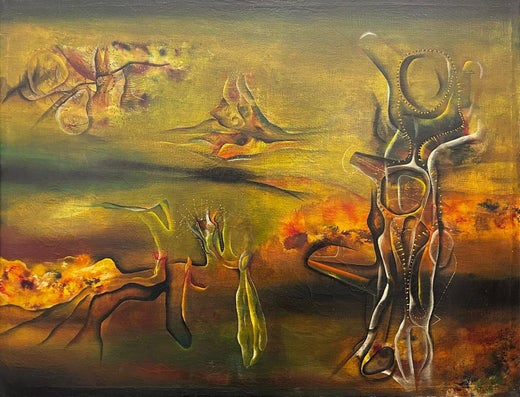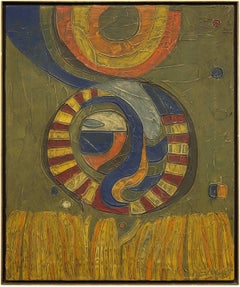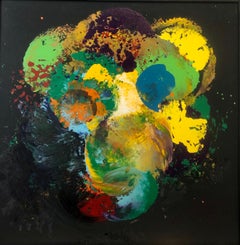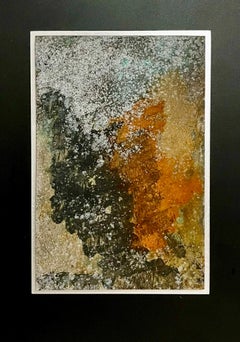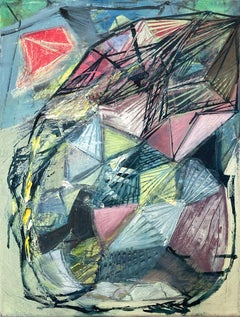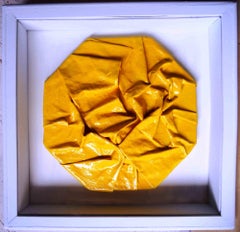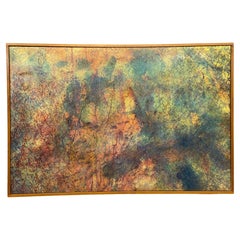Items Similar to Abstract Expressionist Oil Painting Geodesic Dome Shaped Canvas Gerome Kamrowski
Want more images or videos?
Request additional images or videos from the seller
1 of 2
Gerome KamrowskiAbstract Expressionist Oil Painting Geodesic Dome Shaped Canvas Gerome Kamrowski
$35,000
£27,043.57
€31,264.92
CA$49,457.53
A$55,469.91
CHF 29,048.73
MX$674,013.50
NOK 368,870.25
SEK 349,714.99
DKK 233,376.26
About the Item
UNTITLED FROM "DOME SERIES" (it is about 10 inches deep)
Oil and mixed media assemblage on joined canvas panels over a geodesic dome. (He collaborated with Buckminster Fuller)
10 x 60 x 60 in. (25.4 x 152.4 x 152.4cm)
provenance:
The artist.
Fritz Bultman, New York, New York.
By family descent.
Gerome Kamrowski was an American artist and participant in the Surrealist Movement in the United States.
Gerome Kamrowski was one of the few American artists to be included in Peggy Guggenheim's The Art of This Century Gallery in 1943. He also had shows at Museum of Modern Art in New York 1951, Hirshhorn Museum and Sculpture Garden, and at the Whitney Museum of Modern Art, Metropolitan Museum of Art and many more. He showed his work in the 1947 International Surrealist Exhibition in Paris. He was invited to the Paris exhibition by surrealist leader André Breton. Breton would say of him, "Gerome Kamrowski is the one who has impressed me the most by reason of the quality and sustained character of his research." He created massive domes of oil on canvas and brought strange, beaded animals to life. His work balances fluid automatism with powerful abstract imagery. The many layers of paint created a visual maze that clearly communicates an intuitive language with the viewer. Gerome Kamrowski was a pioneer painter. He chose a career of teaching and learning as a way to propagate his artwork. Other painters such as Roberto Matta, Gordon Onslow Ford and Joan Miro shared a common vision with him.
Gerome Kamrowski (January 29, 1914 – March 27, 2004) was an American visual artist and pioneer in the surrealist and abstract expressionist Movements in the United States.
Gerome Kamrowski was born in Warren, Minnesota, on January 19, 1914. In 1932 he enrolled in the Saint Paul School of Art (now Minnesota Museum of American Art - MMAA), where he studied with Leroy Turner, and Cameron Booth. Both Turner and Booth had been students of Hans Hofmann, and were also associated with the Abstraction-Création group in Paris. It was from these peers that Kamrowski was introduced to a "kind of expressionist cubism." In 1933 Kamrowski was awarded a scholarship to the Art Students League, where he would study in New York under Hans Hofmann. Unfortunately immigration problems had prevented Hofmann from assuming his post. Nevertheless, Kamrowski decided to remain in New York for a short time, to attend classes taught by George Grosz. After a few weeks, he returned to St. Paul, and found a position in the mural painting division of the Minnesota FAP/WPA (Works Progress Administration). In 1936 he contributed “Synthetic Cubist Style” frescoes in the Northrup Auditorium of the University of Minnesota.
In 1937 Kamrowski went to Chicago to study under László Moholy-Nagy and Alexander Archipenko at the New Bauhaus (now Illinois Institute of Technology's Institute of Design). There he was exposed to new and interesting ideas regarding the role of nature in art and the "geometric basis of natural form".
In 1938 Kamrowski received a Guggenheim fellowship to attend Hans Hofmann's summer school in Provincetown, Massachusetts. He then relocated to New York where he met William Baziotes. Together they shared a fascination in Surrealist automatic writing, and both artists explored its possibilities in their paintings. Kamrowski was particularly drawn to Surrealism's fundamental appeal of intuition over intellect. He was interested seeking a process that "binds all things together...a kind of cosmic rhythm".
Throughout the late 1930s and early 1940s while living in New York, Kamrowski became an integral part of the emerging surrealists. In 1942, the artist Roberto Matta attempted to form a group of artists to investigate new applications for Surrealist methods. He invited Kamrowski, along with William Baziotes, Jackson Pollock, Peter Busa, and Robert Motherwell to join. Like Kamrowski, the others were more interested in process than in subject matter—the foundation of Matta's art—and the group soon dissolved. But no matter how short lived the collaboration was, this group was the kernel of the open-ended movement that was referred to as abstract surrealism and would over time prove to be the beginnings of abstract expressionism.
It was during this time, the winter of 1939/1940, that an amazing collaboration was made. Kamrowski and two of his contemporaries, William Baziotes and Jackson Pollock, came together and began to paint. The description of this historic event is described as follows in "Pollock" by Ellen G. Landau: "For a number of years, Kamrowski had been involved with Surrealist image-coaxing techniques. In a letter to B.H. Friedman, Kamrowski recalled that one day he, Pollock, and Baziotes were fooling around' with quart-cans of lacquer paint. Baziotes asked if he could use some 'to show Pollock how the paint could be spun around.' He then looked around the room for something to work on, and a canvas that Kamrowski had 'been pouring paint on and was not going well' was handy, so Baziotes began to throw and drip' white paint on it. He next gave the dripping palette knife to Jackson, who with his intense concentration' started flipping the paint with abandon. ' According to Kamrowski, after all had a chance to play, Baziotes identified the spiral forms he had created as 'birds' nests, ' but Pollock refused to interpret his spots." This painting was a pivotal work, showing the transition from, and fusion of, Surrealism to Action Painting and Abstract Expressionism.
In 1947, Kamrowski was invited to the Surrealist Exhibition in Paris by Surrealist leader André Breton. Breton said of him, "Of all the young painters whose evolution I have been able to follow in New York during the last years of the war, Gerome Kamrowski is the one who has impressed me far the most by reason of the "quality" and sustained character of his research. Among all the newcomers there, he was the only one...tunnelling in a new direction..."
In the 1940s Kamrowski relocated to Ann Arbor, Michigan in order to teach at the University of Michigan School of Art. It was a career that would span thirty-eight years, and would encourage countless others to push their artistic boundaries. Professor Jon Rush, at the University's School of Art and Design, stated: "As a teacher, Professor Kamrowski admonished his students to experiment and push the boundaries of their art. He urged them to be unafraid of failure and consider it a natural part of the creative process," and says "Above all, he stressed the importance of finding one's own path and that it would take hard work and dedication to achieve that. He was a natural teacher who related well to students because he himself never stopped being one."
Teaching became a second passion. Over the years, Kamrowski's energy and drive never faltered, and his style continued to evolve dynamically from the abstract intellectual exercises of the past to colorful 3D pieces often made of glass, cement, and random found objects. He worked every day and exhibited steadily in Michigan and elsewhere. He once said, "Michigan has been good to me, don't misunderstand me, but on the other hand I have a certain amount of contempt for it."
He cited architects Antoni Gaudi and Simon Rodia as inspirations
- Creator:Gerome Kamrowski (1914-2004, American)
- Dimensions:Height: 60 in (152.4 cm)Diameter: 60 in (152.4 cm)
- Medium:
- Movement & Style:
- Period:
- Condition:The joined areas between some of the canvas segements are very slightly loosened such that there are a few splits in the paint.
- Gallery Location:Surfside, FL
- Reference Number:1stDibs: LU38216719942
Gerome Kamrowski
Gerome Kamrowski was born in Warren, Minnesota, on January 19, 1914. In 1933 Kamrowski was awarded a scholarship to the Art Students League, where he would study in New York under Hans Hofmann. Kamrowski decided to remain in New York for a short time, to attend classes taught by George Grosz. After a few weeks, he returned to St. Paul, and found a position in the mural painting division of the Minnesota WPA. In 1937 Kamrowski went to Chicago to study under László Moholy-Nagy and Alexander Archipenko at the New Bauhaus. There he was exposed to new and interesting ideas regarding the role of nature in art and the "geometric basis of natural form". In 1938 Kamrowski received a Guggenheim fellowship to attend Hans Hofmann's summer school in Provincetown, Massachusetts. He then relocated to New York where he met William Baziotes. Together they shared a fascination in Surrealist automatic writing, and both artists explored its possibilities in their paintings. Kamrowski was particularly drawn to Surrealism's fundamental appeal of intuition over intellect. He was interested seeking a process that "binds all things together...a kind of cosmic rhythm". Throughout the late 1930s and early 1940s while living in New York, Kamrowski became an integral part of the emerging surrealists. In 1942, the artist Roberto Matta attempted to form a group of artists to investigate new applications for Surrealist methods. He invited Kamrowski, along with William Baziotes, Jackson Pollock, Peter Busa, and Robert Motherwell to join. No matter how short lived the collaboration was, this group was the kernel of the open-ended movement that was referred to as abstract surrealism and would over time prove to be the beginnings of abstract expressionism. It was during this time, the winter of 1939/1940, that an amazing collaboration was made. Kamrowski and two of his contemporaries, Baziotes and Pollock, came together and began to paint. This painting was a pivotal work, showing the transition from, and fusion of, Surrealism to Action Painting and Abstract Expressionism. In 1947, Kamrowski was invited to the Surrealist Exhibition in Paris by Surrealist leader André Breton. Breton said of him, "Of all the young painters whose evolution I have been able to follow in New York during the last years of the war, Kamrowski is the one who has impressed me far the most by reason of the "quality" and sustained character of his research." In the 1940s Kamrowski relocated to Ann Arbor, Michigan in order to teach at the University of Michigan School of Art. It was a career that would span 38 years, and would encourage countless others to push their artistic boundaries. Teaching became a second passion. Over the years, Kamrowski's energy and drive never faltered, and his style continued to evolve dynamically from the abstract intellectual exercises of the past to colorful 3D pieces often made of glass, cement, and found objects. He worked every day and exhibited steadily in Michigan and elsewhere.
About the Seller
4.9
Platinum Seller
Premium sellers with a 4.7+ rating and 24-hour response times
Established in 1995
1stDibs seller since 2014
1,787 sales on 1stDibs
Typical response time: <1 hour
- ShippingRetrieving quote...Shipping from: Surfside, FL
- Return Policy
Authenticity Guarantee
In the unlikely event there’s an issue with an item’s authenticity, contact us within 1 year for a full refund. DetailsMoney-Back Guarantee
If your item is not as described, is damaged in transit, or does not arrive, contact us within 7 days for a full refund. Details24-Hour Cancellation
You have a 24-hour grace period in which to reconsider your purchase, with no questions asked.Vetted Professional Sellers
Our world-class sellers must adhere to strict standards for service and quality, maintaining the integrity of our listings.Price-Match Guarantee
If you find that a seller listed the same item for a lower price elsewhere, we’ll match it.Trusted Global Delivery
Our best-in-class carrier network provides specialized shipping options worldwide, including custom delivery.More From This Seller
View AllGeometric Composition, Abstract Oil Painting
By Robert Neuman
Located in Surfside, FL
Robert S. Neuman was born in Kellogg, Idaho, in 1926. After an honorable discharge from the Air Force in 1946, he received his BA in 1949 and his MFA in 1951, both from the California College of Arts and Crafts in Oakland. He moved from the Bay Area to the East Coast in 1957 where he began teaching art at SUNY New Paltz, then at Massachusetts College of Art, Brown University, and Harvard University’s Carpenter Center for Visual Arts. He received a Fulbright Fellowship for Painting in 1953 and the John S. Guggenheim Foundation Fellowship in 1956. He has been the subject of countless exhibitions, including five solo shows in 2013. Neuman’s work has been on view at the San Francisco Museum of Modern Art, the Whitney Museum of American Art, the Pennsylvania Academy of Fine Art, and the Museum of Modern Art, New York. His work is included in public collections including the Carnegie Museum of Art, Yale University Art Gallery, the Museum of Fine Arts Boston, and the Fogg Art Museum of Harvard University. He died in June 2015.
During the 1950's, Neuman painted in an Abstract Expressionist style, incorporating the stylistic signifiers of the Bay Area School such as broad surface treatments, a full color palette, and atmospheric light. In the 1960's, Neuman's art evolved into geometric abstraction, fusing form and content that often verged on symbolism. He produced various bodies of works such as the Kandinsky-esque cosmos paintings...
Category
Mid-20th Century Abstract Expressionist Abstract Paintings
Materials
Canvas, Oil
Mod Abstract Expressionist Modernist Oil Painting Edward Avedisian Color Circles
By Edward Avedisian
Located in Surfside, FL
Edward Avedisian ( 1936-2007 )
12 X 8.5
Oil paint on wood panel
This is not signed on front. It bears his name verso.
Provenance: Hudson, N.Y. estate of noted Art Collector Albert B...
Category
1960s Abstract Expressionist Landscape Paintings
Materials
Oil, Wood Panel
Charles Clough Picture Generation Abstract Expressionist Oil Enamel Painting
By Charles Clough
Located in Surfside, FL
This vibrant colorful painting is fully hand signed, dated and titled verso.
It might be acrylic but it looks like oil or enamel ad I have seen it described thusly.
This listing is...
Category
1980s Abstract Expressionist Abstract Paintings
Materials
Enamel
Israeli Abstract Expressionist Dina Recanati Cosmos Painting, Sculpture in Metal
By Dina Recanati
Located in Surfside, FL
Dina Recanati
Cosmos Series
(they look like outer space or abstract desert landscapes)
Hand signed and dated
2002
Metallic paint, acid etched on aluminum, wood
Dina Recanati (born Diane Hettena; 1928 – 2021) was an Israeli artist, sculptor and painter.
Diane Hettena was born in Cairo, Egypt. In 1946, she married Raphael Recanati in Tel Aviv, Mandatory Palestine.
Went to London to study History and Art 1946-1948.
Moved to New York 1948. Raised two sons, Oudi and Michael.
Attended Art Student League 1959-1962. Studied with Jose de Creft and John Hovannes.
Beginning in 1964, she was active on the board of the America-israel Cultural Foundation. In the 1970s, she was a member of the board of the Israel Museum and in the 1980s Bezalel Academy of Art & Design, Jerusalem. At the same time as she was working as an artist, she was also collecting artwork. She lives and works in Herzliya and New York.
Most of Recanati's work is in the medium of sculpture. Her works, which contain images of books or parchment, have been influenced by American abstract expressionism in their use of swaths of color. In the 1980s and 1990s, she worked widely in sculptures in the public domain. Dina Recanati was a proponent of Israeli art and supported many Israeli artists. In the 1950s and 1960s, she showcased the work of beginning artists at the 5th Avenue branch of Israel Discount Bank in New York City, while growing Discount Bank’s art collection.
She has gone on to exhibit worldwide with permanent works in the Israel Museum, Tel Aviv Museum, Ben Gurion Airport, The Jewish Museum (New York) among others. She is the recipient of the AICF AVIV Award and The Council for a Beautiful Israel Yakir Award.
She was represented by Flomenhaft Gallery in New York City (was included in the Feminist Art Project along with Miriam Schapiro) and Gordon Gallery in Tel Aviv.
Recanati died in Herzliya Pituah at the ate of 93.
Israeli Art: Painting, Sculpture, Graphic Work. Tel Aviv Museum of Art, Tel Aviv 1971
Artists: Igael Tumarkin, Bezalel Schatz, Yehiel Shemi, Buky Schwartz, Dina Recanati, Menashe Kadishman, David Palombo, Itzhak Danziger, Sorel Etrog, Yaacov Agam, Jakob Steinhardt, Louise Schatz, Anna Ticho, Ruth Schloss, Moshe Castel, Yohanan Simon, Lea Nikel, Marcel Janco, Mordecai Ardon etc.
40 From Israel: Contemporary Sculpture & Drawing Israel: Contemporary Sculpture & Drawing Brooklyn...
Category
Early 2000s Abstract Expressionist Abstract Paintings
Materials
Metal
Charles Clough Picture Generation Abstract Expressionist Oil Enamel Painting
By Charles Clough
Located in Surfside, FL
This vibrant colorful painting is fully hand signed, dated and titled verso.
It might be acrylic but it looks like oil or enamel ad I have seen it described thusly.
This listing is...
Category
1980s Abstract Expressionist Abstract Paintings
Materials
Enamel
Large Abstract Expressionist Painting Richard Heinsohn from Allan Stone Gallery
Located in Surfside, FL
Richard Heinsohn (American, -1961)
"Life Forms in Transit,"
Hand signed and dated 1988 verso.
Provenance: Allan Stone Gallery, New York.
Education...
Category
1980s Abstract Expressionist Abstract Paintings
Materials
Acrylic Polymer, Cotton Canvas, Acrylic
You May Also Like
"Geodesic Composition" Greek Abstract Expressionist Oil Painting on Canvas
By Eozen Agopian
Located in New York, NY
This piece is a bold display of Eozen Agopian's structurally strong pieces, with an intense color of Blue and green and pops of blue, pink and white, mim...
Category
Early 2000s Abstract Expressionist Abstract Paintings
Materials
Canvas, Mixed Media, Oil
Octagonal Composition - Painting by Giuseppe Zumbolo - 2021
Located in Roma, IT
Plied canvas painted in enamel.
Small format ma great effect.
Certificate of authenticity by the Artist.
Category
2010s Abstract Abstract Paintings
Materials
Mixed Media
Stellar Web Post-Modern Abstract Painting
Located in Garnerville, NY
Large Post-Modern abstract painting on canvas. Titled on the stretcher. Unsigned. Possibly tempera or acrylic medium.
Overall approximate measurements with the frame are 2.5" deep ...
Category
Vintage 1980s American Post-Modern Paintings
Materials
Canvas, Paint
$1,080 Sale Price
20% Off
Mixed media, oil painting, Stanley Boxer, Bluhme (Bloom)
By Stanley Boxer
Located in White Plains, NY
Available at Madelyn Jordon Fine Art. 'Bluhme (Bloom)' by Stanley Boxer, 2000. Oil and mixed media on canvas, 10 x 10 in. / Frame: 11 x 11 in. ...
Category
Early 2000s Abstract Abstract Paintings
Materials
Canvas, Mixed Media, Oil
Moises Ramos Mixed Media Abstract Painting 20th Century
Located in San Francisco, CA
Moises Ramos Mixed Media Abstract Painting 20th Century
Mixed media with oils and acrylics on canvas
Canvas dimensions 29" wide x 22.5" high
The frame measures 30.25" wide x 24" h...
Category
Late 20th Century Abstract Abstract Paintings
Materials
Canvas, Oil, Acrylic
Vintage Mid Century Modern Abstract Expressionist Ethereal Organic Oil Painting
By Piry Rame
Located in Buffalo, NY
Vintage abstract expressionist etherial oil painting by Piry Rame (1921 - 2001). Oil on canvas, circa 1960. Signed on verso. Image size, 21L x 16H. Housed in a period frame.
Category
1960s Abstract Expressionist Landscape Paintings
Materials
Canvas, Oil
